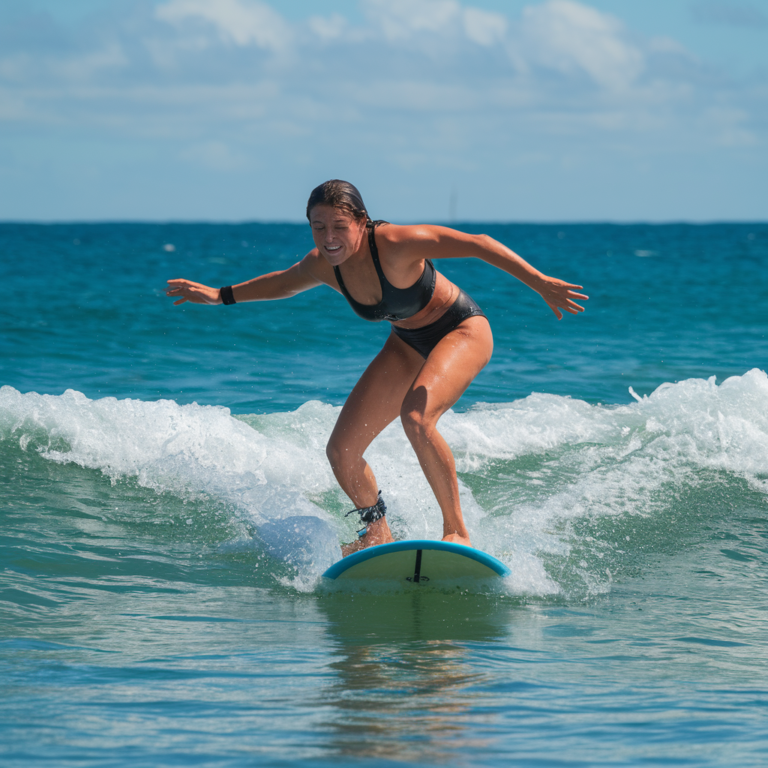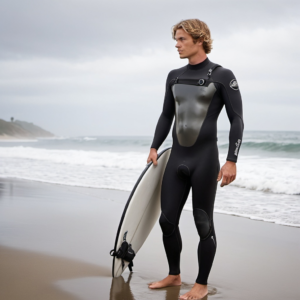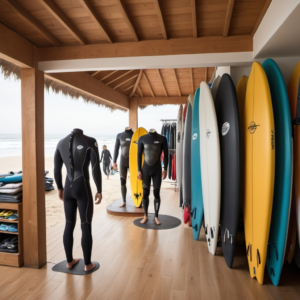There’s nothing quite like the exhilarating rush of standing up on your surfboard and cruising through the surf. But before you can master that flawless pop-up and smooth ride, it’s crucial to avoid common pitfalls that can make your surfing journey a bit rocky.
In this guide, we’ll dive into the 10 Common Mistakes that many beginners make when trying to stand up on a surfboard. Whether you’re struggling with balance, timing, or technique, understanding these frequent errors can help you correct your course and improve your performance in the water. Surfing is as much about technique and practice as it is about passion and thrill. So, let’s break down these mistakes, learn from them, and get you one step closer to conquering those waves!
Overview
When it comes to standing up on a surfboard, it’s not just about having the right board or the perfect wave—it’s about mastering the art of balance, timing, and technique. New surfers often stumble on the same issues, leading to frustrating wipeouts and missed opportunities to catch that perfect wave.
-
Inconsistent Pop-Up Technique
The pop-up is your gateway to standing on the board, and inconsistency here can be a major roadblock. Many beginners struggle with the timing and execution of their pop-up, leading to wobbly stands and premature falls. It’s crucial to practice a fluid, explosive motion that propels you from a prone position to standing with smooth precision.
-
Poor Stance Alignment
Once you’re up, maintaining a balanced stance is key. A common mistake is having feet that are too close together or misaligned. Your feet should be shoulder-width apart and parallel to the board’s stringer for optimal balance. A misaligned stance can throw off your center of gravity and make you more susceptible to falling.
-
Over-Gripping the Rails
It’s tempting to grip the rails of your board for stability, but over-gripping can actually hinder your balance. Instead, keep a relaxed grip and use your core muscles to maintain stability. Over-gripping can also cause unnecessary strain and disrupt your fluid movement on the board.
-
Not Reading the Wave Correctly
Understanding the wave dynamics is crucial for timing your pop-up and positioning. Many beginners make the mistake of trying to stand up too early or too late, which can result in missed waves or awkward rides. Learn to read the wave’s shape and power to time your pop-up accurately.
-
Forgetting to Bend Your Knees
Straight legs can be a major issue when trying to maintain balance on a surfboard. Locked legs can lead to instability and make it harder to maneuver on the board.
-
Neglecting Core Engagement
Your core is your center of balance and power. Make sure to tighten your abs and back muscles as you pop up and ride the wave to keep your movements stable and controlled.
-
Incorrect Weight Distribution
Proper weight distribution is crucial for balance and control. Many surfers make the mistake of leaning too far forward or backward, which can cause the board to nosedive or pearl. Aim to distribute your weight evenly and stay centered over the board to maintain stability.
-
Not Utilizing Proper Paddle Technique
Effective paddling is the precursor to a successful stand-up. Inefficient paddling can leave you out of position and out of breath, making it harder to pop up smoothly. Focus on a strong, steady paddle stroke to ensure you’re in the right spot when you’re ready to stand.
-
Misjudging the Surf Conditions
Surf conditions can vary greatly, and beginners often misjudge their ability to handle different types of waves. Assess the conditions before hitting the water and choose waves that match your skill level. Trying to tackle waves that are too advanced can lead to unnecessary wipeouts and frustration.
-
Lack of Practice and Patience
Many beginners give up too quickly when they don’t see immediate improvement. Consistent practice and patience are key to mastering the art of standing up on a surfboard. Embrace the learning process and keep honing your skills.
Where to Buy Surfboards: A Comparison Guide
Choosing the right surfboard and finding the best place to buy it can be a daunting task for beginners and seasoned surfers alike. With a multitude of options available online and in physical stores, it’s essential to make an informed decision to ensure you get a board that suits your needs and budget. To help simplify your decision, we’ve put together a comparison of popular surfboard retailers, highlighting key aspects such as price range, customer service, and variety of options.
-
Local Surf Shops
Pros:
- Personalized advice from experienced surfers.
- Ability to physically inspect and test boards.
- Support for local businesses.
Cons:
- Limited stock compared to larger retailers.
- Prices can be higher due to overhead costs.
Best For: Those who prefer hands-on shopping and value personalized recommendations.
-
Online Specialty Retailers
Pros:
- Extensive range of surfboards and accessories.
- Competitive pricing and frequent sales.
- Convenient shopping from home.
Cons:
- Cannot physically inspect the board before purchase.
- Shipping costs and potential delays.
Best For: Surf enthusiasts looking for a broad selection and good deals without the need for in-person shopping.
-
Big Box Retailers
Pros:
- Affordable options and frequent promotions.
- Convenient locations and online shopping.
Cons:
- Limited expertise and customer service.
- Lower quality boards compared to specialized surf shops.
Best For: Budget-conscious buyers looking for basic surfboards and accessories.
-
Custom Surfboard Makers
Pros:
- Tailored boards designed to meet individual needs.
- High-quality craftsmanship and unique designs.
Cons:
- Higher cost due to custom design and materials.
- Longer wait time for production and delivery.
Best For: Surfers who want a personalized board built to their specific requirements.
| Retailer | Variety | Customer Service | Notes |
| Local Surf Shops | Moderate | High (personalized advice) | Best for personalized recommendations |
| Online Specialty Retailers | Extensive | Medium (varies by retailer) | Great for variety and deals |
| Big Box Retailers | Limited | Low (less expertise) | Affordable but basic options |
| Custom Surfboard Makers | Customizable | High (specialized advice) | Ideal for custom and high-quality boards |
Where to Buy Tips:
- Research Before Buying: Whether shopping online or in-store, research the surfboard’s specs and reviews. Look for customer feedback on the retailer’s service and delivery.
- Compare Prices: Prices can vary significantly, so compare costs across different retailers to ensure you’re getting the best deal.
- Check Return Policies: Make sure the retailer has a clear and fair return policy in case the board doesn’t meet your expectations or has defects.
- Consider Shipping Costs: For online purchases, factor in shipping costs and potential additional fees.
Common Mistakes to Avoid When Standing Up on a Surfboard
Mastering the art of standing up on a surfboard involves more than just balancing on the board. It’s a skill that combines timing, technique, and the ability to read the waves. Let’s dive into some common mistakes that surfers often make when trying to stand up, and how to avoid them.
-
Incorrect Hand Placement
One of the most frequent errors is improper hand placement during the pop-up. Surfers sometimes place their hands too wide or too close together, which can destabilize the board. To correct this, ensure your hands are positioned shoulder-width apart. This helps in creating a stable base and facilitates a smoother transition from prone to standing.
-
Misjudging Wave Timing
Timing is everything when it comes to catching and riding a wave. Many beginners attempt to stand up too early or too late. Standing up too soon can lead to a nosedive, while standing up too late might result in missing the wave. To improve your timing, observe the wave’s pattern and practice popping up in sync with the wave’s crest.
-
Failing to Engage Core Muscles
A robust core is indispensable for preserving equilibrium on a surfboard. Disengaging the core musculature can precipitate instability and oscillatory motion. Prioritize contracting the abdominal and lumbar muscles as you assume a standing position. This strategic engagement facilitates centralized positioning on the board and enhances responsiveness to the wave’s dynamic fluctuations.
-
Incorrect Foot Positioning
Your foot placement significantly impacts your balance. Placing your feet too far forward or backward can throw off your equilibrium and make it difficult to maneuver. Aim to position your feet about shoulder-width apart and centered on the board.
-
Overlooking the Importance of Flexibility
Flexibility plays a key role in surfing, especially when adjusting to the board’s movements. Many surfers make the mistake of standing rigidly, which can cause them to lose balance. Keep your knees slightly bent and stay loose to adapt to the wave’s changing dynamics. This flexibility will help you absorb the wave’s energy and stay balanced.
-
Ignoring the Surfboard’s Design
Different surfboards are designed for various conditions and skill levels. Using a board that’s not suited for your experience level or the current wave conditions can make standing up more challenging. For example, beginners might benefit from a larger, more stable board, while advanced surfers might opt for a shorter, more maneuverable one.
FAQs: Standing Up on a Surfboard
What is the best technique for popping up on a surfboard?
The pop-up technique is crucial for standing up on a surfboard. Start by paddling to gain momentum and positioning yourself in the right spot on the wave. As the wave approaches, place your hands under your shoulders, press up, and bring your feet underneath you in one fluid motion.
How can I improve my balance on the surfboard?
Enhancing balance requires a synergistic approach encompassing both physical conditioning and practical application. Fortifying core musculature through exercises such as planks and leg raises is paramount for establishing a stable foundation. Complementarily, incorporating balance drills on unstable surfaces like stability balls or balance boards can expedite progress. Within the aquatic environment, maintaining a flexed knee posture and centralizing weight distribution over the board are crucial. Consistent surf practice serves as a catalyst for gradual balance refinement.
What are the key factors to consider when choosing a surfboard?
Choosing the right surfboard depends on several factors:
- Skill Level: Beginners often benefit from larger, more stable boards, while advanced surfers might prefer smaller, more maneuverable boards.
- Wave Conditions: Match your board to the typical wave conditions where you’ll be surfing. Larger boards work well in smaller, softer waves, while shorter boards are better for larger, more powerful waves.
- Board Type: There are different types of boards, including longboards, shortboards, and fish boards. Each has its own characteristics suited to various surfing styles and conditions.
How do I know if I’m standing on the board correctly?
To check if you’re standing correctly, ensure your feet are about shoulder-width apart and centered on the board. Your knees should be slightly bent, and your body should be upright and relaxed. Look for signs of stability, such as a smooth ride and control over the board. If you’re wobbling or having difficulty maneuvering, adjust your stance and try to maintain a lower center of gravity.
What common mistakes should I avoid while standing up on a surfboard?
Common mistakes include:
- Incorrect Foot Positioning: Feet placed too far forward or back can throw off your balance.
- Over-Gripping the Rails: This can disrupt your balance and cause strain.
- Poor Timing: Standing up too early or too late can result in a missed wave or nosedive.
- Neglecting Core Engagement: A weak core can lead to instability and difficulty in controlling the board.
- Ignoring Wave Dynamics: Misjudging the wave’s power and timing can affect your ride.
How often should I practice to get better at surfing?
Consistency is key in surfing. Aim to practice regularly, ideally several times a week, to build and maintain your skills. Frequent practice helps improve muscle memory, balance, and overall technique. Even if you can’t get to the water often, doing land-based exercises and practicing your pop-up technique on the beach can be beneficial.
What should I do if I’m struggling to stand up on the board?
If you’re struggling, consider breaking down the process into smaller steps. Focus on perfecting your pop-up technique on land before trying it in the water. Work on your balance and core strength through targeted exercises. Additionally, take lessons from a professional instructor who can provide personalized feedback and guidance. Remember, persistence and practice are crucial to overcoming challenges in surfing.
Conclusion
Mastering the art of standing up on a surfboard is a blend of technique, practice, and perseverance. From perfecting your pop-up to maintaining balance and understanding wave dynamics, every aspect of surfing requires attention to detail and continual improvement. Surfing is as much about enjoying the process as it is about achieving mastery. Regular practice, combined with targeted exercises and a focus on proper technique, will lead to gradual improvements and a more enjoyable surfing experience. Whether you’re shopping for the perfect board or trying to get that pop-up just right, staying informed and adaptable will enhance your overall performance.
In the end, the thrill of standing up on your board and riding a wave is a rewarding experience that makes all the effort worthwhile. So, keep paddling, keep practicing, and most importantly, keep having fun out there. The waves are waiting, and with each ride, you’re one step closer to becoming the surfer you aspire to be.
If you found that interesting, you might also like the following articles:
10 Tips on How to Learn to Surf on a Shortboard




